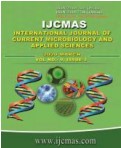


 National Academy of Agricultural Sciences (NAAS)
National Academy of Agricultural Sciences (NAAS)

|
PRINT ISSN : 2319-7692
Online ISSN : 2319-7706 Issues : 12 per year Publisher : Excellent Publishers Email : editorijcmas@gmail.com / submit@ijcmas.com Editor-in-chief: Dr.M.Prakash Index Copernicus ICV 2018: 95.39 NAAS RATING 2020: 5.38 |
Soil organic carbon (SOC) and Soil inorganic carbon (SIC) are important as it determine ecosystem and agro-ecosystem functions influencing soil structure, soil fertility, water holding capacity, cation exchange capacity and other soil characteristics. It is also of global importance because of its role in the global carbon cycle(GCC). The understanding of soil carbon in terms of its amount and quality is essential to sustain the quality and productivity of soils. With this view an attempt was made to assess the carbon storage under diverse horticultural cropping systems in Parbhani district of Maharashtra. Twelve major fruit orchard soil samples from Parbhani district of Marathwada region at a depth of 0-30 cm and 30-60 cm were collected for investigation. The results emerged out indicated that soil organic carbon (SOC) content of orchards soil at 0-30 cm depth ranged from 21.60 to 25.86 Mg ha-1 and at 30-60 cm depth it was ranged from 18.54 to 23.13 Mg ha-1. It decreased with the increase in depth. At both the depths, highest SOC recorded in mango orchard soils followed by orange , pomegranate orchards soil. At both the depths, highest soil inorganic carbon (SOI) recorded under mango followed by pomegranate orchard soil sample. The subsurface soils (30-60 cm) showed higher content inorganic carbon than surface soil (0-30 cm) which exhibited an increasing trend with increase in depth. The SOC was positively correlated with total organic carbon (r=0.886** and r=0.917**) at 0-30 cm and 30-60 cm depth of soil respectively. The SIC was positively correlated with total organic carbon (r=0.961** and r =0.954**) at 0-30 cm and 30-60 cm depth of soil respectively. The SIC in soils of semiarid climate is one of the major reservoir of carbon near the surface environment, have a potential in mitigating the effects of global climate change by sequestering the atmosphere carbon in the form of SIC (Pedogenic Carbonate).
 |
 |
 |
 |
 |